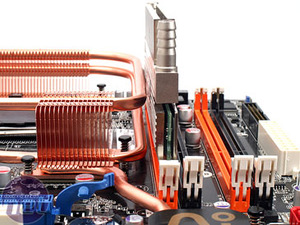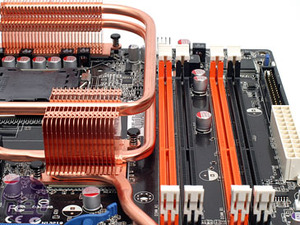The P5K3 is another black PCB Asus motherboard but this time with black and orange memory slots instead. The heatpipe arrangement has also been updated and improved to Striker Extreme level, with almost a full circular array of dual pipeage surrounding the CPU socket.
This means that all eight phases of PWMs are equally cooled, along with the northbridge and southbridge creating some of the best heat distribution available.
The only problem with the updated tubes of copper is that it creates an inch deep enclosure around the CPU, which means large heatsinks with mounting plates might have a problem. For example: Asus' own Silent Square Pro heatsink only fits one way and prevents you from using the additional heatpipe fan, but the (arguably better) Zalman CNPS9700/9500 works just fine.
The heatpipes are also desperately close to the memory, however the Corsair XMS3-1333 we used fits perfectly fine in the closest slot. Even OCZ’s “heavy round the midriff with a crazy hairstyle” FlexXLC should fit fine when it launches its range of DDR3 modules at Computex.
This is where the differentiation between the Asus P5K Deluxe and P5K3 Deluxe stops.
Like the P5K Deluxe, the north and southbridge heatsinks are actually quite small in comparison to other recent motherboards, but they still adequately cool the board's components.
The memory slots are quite low down on the board, but they still don’t infringe on the top PCI-Express x16 slot. The orange and black colour differentiation is to provide identification of memory channels, where two memory modules should be installed in matching colours for dual channel operation.
The main PCI-Express x16 slot is coloured blue and is easily distinguishable from the lower x16 slot (x4 electrical) which is in black. The P35 chipset does support ATI CrossFire but we’re currently waiting on AMD to release the next Catalyst drivers to support it. There are also two PCI-Express x1 slots and three legacy PCI slots all coloured white. If you use the second somewhat crippled PCI-Express x16 slot, then both PCI-Express x1 slots are disabled.

Although you'll lose one of the PCI slots if you use a graphics card with a dual slot cooler, there are still two available to use. The overall network connectivity is immense, with the board incorporating 802.11g wireless and two Gigabit Ethernet ports.
The wireless does take up two USB ports but, given that the chipset supports 12 natively, that isn’t too much of a problem. Only one of the Gigabit Ethernet sockets is PCI-Express (top RJ45 socket), with the other (lower RJ45 socket) being PCI-based only. This is due to a motherboard limitation; with only six PCI-Express lanes available from the southbridge, four go to the PCI-Express slots leaving one for the Marvell Gigabit Ethernet and the other for the JMicron eSATA/PATA controller.
Hard drive connectivity is supplied by the southbridge and aforementioned JMicron JMB363 controller. The southbridge supplies six internal 3Gbps SATA ports, with all the ports on the board placed along the edge of the board between and not in line with PCI-Express x16 ports, so as not to get in the way of long graphics cards.
JMicron JMB363 is a PCI-Express controller for one ACHI/legacy IDE connector and two dedicated eSATA ports on the rear I/O. All SATA ports support Native Command Queuing (NCQ), hot plugging, ATAPI devices, port multiplier with command-based switching supporting and programmable output swing control to suit eSATA connections.
Agere supplies the IEEE1394a Firewire through two ports, one on the rear I/O and another using an on-board pin-out. The pin-out has a red plastic shroud which means you can easily identify it and only plug in the PCI bracket in a single orientation. The same goes for the (four) blue USB 2.0 ports and (turquoise) RS232 serial port.
The front panel pin-out is coloured green, but lacks the shroud. Unfortunately though, it is not colour coded but does provide a small printed diagram on the PCB as to where everything should be plugged in. In addition, there is also the excellent Q-connector included in the bundle too, which means that you don't need to fiddle about with wires inside your case. Instead, just connect the wires to the Q-connector and then plug the whole thing into the front panel pin header. Genius!
Sound comes from the ADI SoundMAX ADI1998B audio codec, which provides High Definition 7.1 surround sound and independent headphone outputs at up to 32bit/192KHz playback through digital S/PDIF or analogue 3.5mm jacks. It contains 10 DACs for playback with a 101dB dynamic range, and six ADCs with recording capability of a 96dB dynamic range.
Overall the general layout is very good, with all the sockets, including fan plugs placed around the edges of the board for easy access.
This means that all eight phases of PWMs are equally cooled, along with the northbridge and southbridge creating some of the best heat distribution available.
The only problem with the updated tubes of copper is that it creates an inch deep enclosure around the CPU, which means large heatsinks with mounting plates might have a problem. For example: Asus' own Silent Square Pro heatsink only fits one way and prevents you from using the additional heatpipe fan, but the (arguably better) Zalman CNPS9700/9500 works just fine.
The heatpipes are also desperately close to the memory, however the Corsair XMS3-1333 we used fits perfectly fine in the closest slot. Even OCZ’s “heavy round the midriff with a crazy hairstyle” FlexXLC should fit fine when it launches its range of DDR3 modules at Computex.
This is where the differentiation between the Asus P5K Deluxe and P5K3 Deluxe stops.
Like the P5K Deluxe, the north and southbridge heatsinks are actually quite small in comparison to other recent motherboards, but they still adequately cool the board's components.
The memory slots are quite low down on the board, but they still don’t infringe on the top PCI-Express x16 slot. The orange and black colour differentiation is to provide identification of memory channels, where two memory modules should be installed in matching colours for dual channel operation.
The main PCI-Express x16 slot is coloured blue and is easily distinguishable from the lower x16 slot (x4 electrical) which is in black. The P35 chipset does support ATI CrossFire but we’re currently waiting on AMD to release the next Catalyst drivers to support it. There are also two PCI-Express x1 slots and three legacy PCI slots all coloured white. If you use the second somewhat crippled PCI-Express x16 slot, then both PCI-Express x1 slots are disabled.

| Key: | |||
| 1. | JMicron JMB363 eSATA ad IDE controller | 10. | Four DDR3 240 pin memory slots |
| 2 | PCI-Express x16 slot (x4 electrical) | 11. | 6 SATA 3Gbps (red eSATA compatible) |
| 3. | ADI Soundmax ADI1988B HD Audio codec | 12. | Front pin-out |
| 4. | PCI-Express x16 slot (x16 electrical) | 13. | IDE port |
| 5. | Realtek RTL8110SC PCI Gigabit Ethernet | 14. | USB 2.0 pin-out (four ports) |
| 6. | Realtek RTL8187L Wireless 802.11g | 15. | Agere FW3227 IEEE1394a Firewire |
| 7. | Marvell 88E8056-NNC1 PCI-Express Gigabit Ethernet | 16. | Firewire pin-out (one port) |
| 8. | Floppy controller | 17. | RS232 COM port pin-out |
| 9. | 24pin ATX socket | 18. | Front audio pin-out |
Although you'll lose one of the PCI slots if you use a graphics card with a dual slot cooler, there are still two available to use. The overall network connectivity is immense, with the board incorporating 802.11g wireless and two Gigabit Ethernet ports.
The wireless does take up two USB ports but, given that the chipset supports 12 natively, that isn’t too much of a problem. Only one of the Gigabit Ethernet sockets is PCI-Express (top RJ45 socket), with the other (lower RJ45 socket) being PCI-based only. This is due to a motherboard limitation; with only six PCI-Express lanes available from the southbridge, four go to the PCI-Express slots leaving one for the Marvell Gigabit Ethernet and the other for the JMicron eSATA/PATA controller.
Hard drive connectivity is supplied by the southbridge and aforementioned JMicron JMB363 controller. The southbridge supplies six internal 3Gbps SATA ports, with all the ports on the board placed along the edge of the board between and not in line with PCI-Express x16 ports, so as not to get in the way of long graphics cards.
JMicron JMB363 is a PCI-Express controller for one ACHI/legacy IDE connector and two dedicated eSATA ports on the rear I/O. All SATA ports support Native Command Queuing (NCQ), hot plugging, ATAPI devices, port multiplier with command-based switching supporting and programmable output swing control to suit eSATA connections.
Agere supplies the IEEE1394a Firewire through two ports, one on the rear I/O and another using an on-board pin-out. The pin-out has a red plastic shroud which means you can easily identify it and only plug in the PCI bracket in a single orientation. The same goes for the (four) blue USB 2.0 ports and (turquoise) RS232 serial port.
The front panel pin-out is coloured green, but lacks the shroud. Unfortunately though, it is not colour coded but does provide a small printed diagram on the PCB as to where everything should be plugged in. In addition, there is also the excellent Q-connector included in the bundle too, which means that you don't need to fiddle about with wires inside your case. Instead, just connect the wires to the Q-connector and then plug the whole thing into the front panel pin header. Genius!
Sound comes from the ADI SoundMAX ADI1998B audio codec, which provides High Definition 7.1 surround sound and independent headphone outputs at up to 32bit/192KHz playback through digital S/PDIF or analogue 3.5mm jacks. It contains 10 DACs for playback with a 101dB dynamic range, and six ADCs with recording capability of a 96dB dynamic range.
Overall the general layout is very good, with all the sockets, including fan plugs placed around the edges of the board for easy access.

MSI MPG Velox 100R Chassis Review
October 14 2021 | 15:04











Want to comment? Please log in.